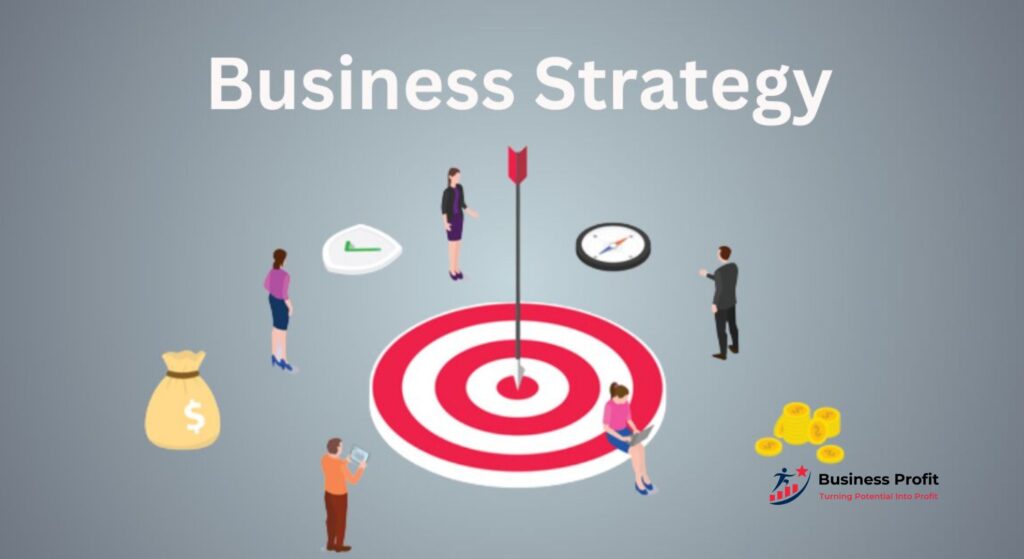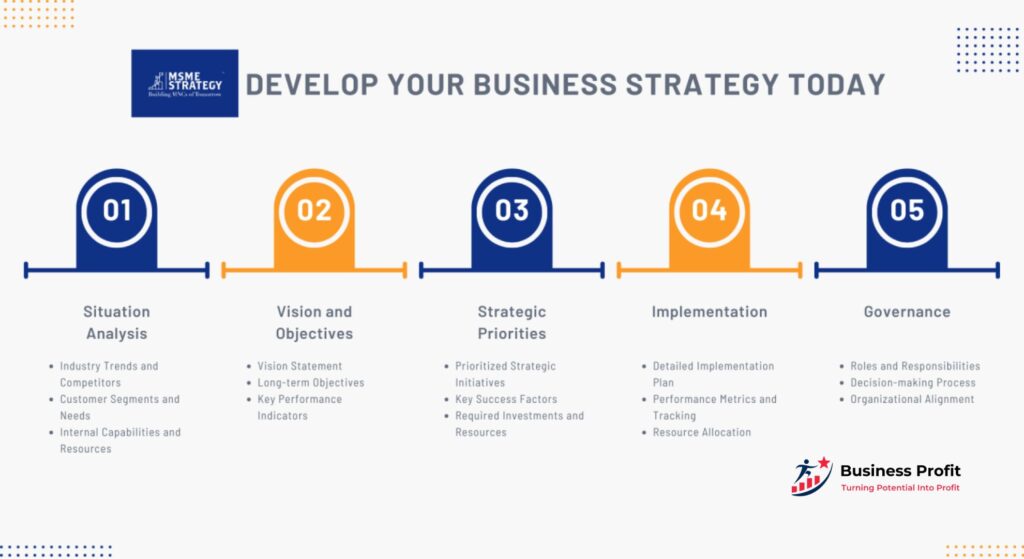
Have you ever dreamed of designing a magnificent skyscraper that dominates the skyline? For business analysts, crafting a winning business strategy holds a similar power. The blueprint forms your business’s future, ensuring it stays ahead of the competition and is successful in the long run. This blog equips you with the tools and knowledge to transform from business analyst to strategic architect. We’ll provide a step-by-step guide, explore common challenges, and unveil valuable resources to empower you in building a rock-solid business strategy. Let’s get started on designing your organization’s masterpiece!
Understanding Business Strategy with Business Analyst: The Cornerstone of Success
A business strategy is the overarching plan that defines an organization’s goals, outlines its competitive advantage, and details the actions required to achieve long-term success. It’s a dynamic document that should evolve alongside the ever-changing business landscape.
Here’s a breakdown of the critical components of a well-defined business strategy:
- Mission and Vision: The goal statement outlines the company’s current activities, and the vision statement outlines its future goals. These statements are compass points that ensure everyone in the company is working toward the same objective.
- Situational Analysis: This involves thoroughly assessing the internal and external environment. The internal analysis evaluates the company’s strengths and weaknesses (SWOT analysis), while the external analysis examines opportunities and threats (OT analysis).
- Competitive Advantage: Tell me about what makes your business unique. Yousucceedure your unique selling determiner (USP) to create a place in the market.
- Goals and Objectives: Clearly defined goals provide a roadmap for achieving your vision. These goals should be SMART – Specific, Measurable, Achievable, Relevant, and Time-bound. Objectives then break down these goals into actionable steps.
- Action Plan: This translates strategy into action. It outlines the specific initiatives, resources, and timelines required to achieve your objectives.
Developing a Business Strategy with Business Analyst: A Step-by-Step Guide

So that we know what the most essential parts of a business plan are, let’s look at how to make one step by step:
1. Define your Mission and Vision:
- What problem does your company solve, and how does it contribute value to the market?
- Where do you see your company in the next 3-5 years?
2. Conduct a Situational Analysis:
- Internal Analysis: Evaluate your company’s strengths (resources, skills, experience) and weaknesses (operational inefficiencies, lack of resources). Tools like SWOT analysis can help you visualize this effectively.
- External Analysis: Identify opportunities (emerging markets, technological advances) and threats (industry regulations, competitor actions) that could impact your business.
3. Identify Your Competitive Advantage:
- What makes you stand out from the crowd? Is it your innovative product line, exceptional customer service, or cost-effective solutions?
4. Set SMART Goals and Objectives:
- Goals: Outline your desired outcomes in specific and measurable terms. For example, “Increase market share by 15% within the next year.”
- Objectives: Divide your goals into steps that you can take and give yourself due dates. This could mean starting a new advertising effort or moving into a different area.
5. Develop an Action Plan:
- Initiatives: Define the specific projects or activities required to achieve your objectives.
- Resources: Identify the resources needed to execute these initiatives, including workforce, budget, and technology.
- Timeline: Set realistic deadlines for each initiative to ensure timely progress and achievement of goals.
6. Communication and Monitoring:
- Once your business strategy is in place, effectively communicate it across all levels of the organization.
- Regularly monitor progress and adapt your strategy based on market trends and initial feedback.
Business Analyst Role in Crafting Business Strategy
Business analysts play a pivotal role in crafting winning business strategies. Here’s how your skillset empowers you to contribute significantly:
- Data Analysis and Interpretation: Your expertise in data analysis allows you to gather and analyze critical business information, providing insights that inform strategic decision-making.
- Process Improvement: You can identify inefficiencies within existing operations and recommend process improvements to enhance overall effectiveness.
- Stakeholder Management: You act as a bridge between different departments and stakeholders, facilitating communication and ensuring everyone is aligned with the strategic vision.
- Project Management: Your project management skills can be instrumental in driving the implementation of strategic initiatives and ensuring they stay within scope and budget.
Common Challenges in Developing a Business Strategy with a Business Analyst

Even the most meticulous planning can encounter roadblocks. Here are some common challenges you might face while developing a business strategy:
- Lack of Stakeholder Alignment: It is crucial to ensure everyone within the organization understands and supports the strategy. Open communication and buy-in from key stakeholders are essential for successful implementation.
- Unrealistic Goals: Setting ambitious goals is essential but must also be achievable. Conduct thorough research and analysis to ensure your goals are grounded in reality and have a clear roadmap for achievement.
- Data Inaccuracy or Incompleteness: Strategic decisions are best based on reliable data. Strategies can go wrong when data is inaccurate or incomplete. Ensure you have access to high-quality data and conduct a thorough analysis to extract meaningful insights.
- Resistance to Change: Implementing a new strategy often involves changes to existing processes or workflows. Some employees might resist these changes. Effective communication, training, and addressing concerns can help overcome this resistance.
- Lack of Agility: The business landscape is constantly evolving. A rigid strategy that doesn’t adapt to changing market conditions is unlikely to succeed. Build flexibility into your plan to allow course correction when necessary.
Tools and Resources for Business Analysts
Crafting a winning business strategy requires the right tools and resources. Here are some valuable resources to empower you as a business analyst:
- Business Process Modelling Tools: Tools like BPMN (Business Process Model and Notation) help visualize and analyze existing processes, allowing you to identify areas for improvement.
- Data analytics Platforms: These platforms provide powerful tools for data analysis, enabling you to extract valuable insights from large datasets to inform strategic decisions.
- Project Management Software: Effectively managing the implementation of strategic initiatives is crucial. Managing project software helps you track work, track resources, and ensure that deliverables are met on time and budget.
- Industry Reports and Market Research: Knowing what your competitors are doing and how the market is changing is essential. Industry reports, market research data, and rival analysis tools. Can give you a full picture of your competitors
- Business Strategy Frameworks: Frameworks like the Balanced Scorecard and SWOT analysis provide a structured approach to developing and analyzing your business strategy.
Using these tools and resources, you can speed up the process of making a plan, learn valuable things, and do your best work as a business analyst.
Because you are a business analyst and can use your essential skills in this blog, you can help guide your company to success. Remember that a business plan is a living document that needs to be reviewed and changed constantly. Keep up with changes in the market, what customers are saying, and what your competitors are doing to ensure that your plan stays useful and effective.
Ready to take your business analysis skills to the next level? Check out all of Business Profit’s services at Business Profit. From strategic analysis to marketing expertise, Business Profit provides the tools and resources you need to empower your organization and achieve its full potential.
FAQ’s
What role does a business strategy play in the success of an organization?
A business strategy serves as a roadmap, guiding the organization toward its goals and helping it stay competitive. It shows how the business will use its strengths, fix its weaknesses, take advantage of opportunities, and lessen threats to be successful in the long run.
How does a business analyst contribute to crafting a business strategy?
Business analysts bring valuable skills such as data analysis, process improvement, stakeholder management, and project management. They gather and analyze data, identify areas for improvement, facilitate communication among stakeholders, and drive the implementation of strategic initiatives.
What are some common challenges in developing a business strategy?
Common challenges include stakeholder alignment, setting realistic goals, ensuring data accuracy and completeness, overcoming resistance to change, and maintaining agility in a constantly evolving business landscape. Addressing these challenges requires effective communication, thorough analysis, and flexibility in approach.
What tools and resources are available to business analysts for crafting a business strategy?
Business analysts can leverage tools such as business process modelling software, data analytics platforms, project management software, and industry reports. These resources help them visualize processes, analyze data, manage projects, and stay informed about market trends and competitors.
Why is continuously reviewing and adapting a business strategy important?
The business landscape is dynamic, with market conditions, customer preferences, and competitor actions constantly changing. A business strategy must evolve accordingly to remain relevant and practical. Continuous review and adaptation ensure that the organization stays aligned with its goals and is responsive to external factors.
